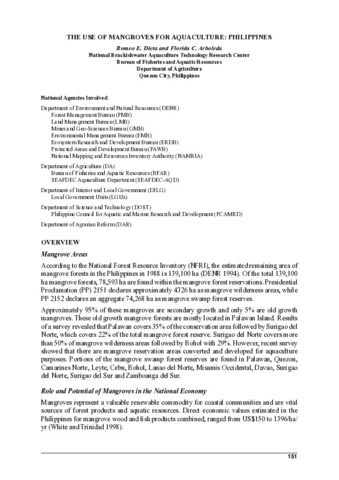The use of mangroves for aquaculture: Philippines
- Global styles
- MLA
- Vancouver
- Elsevier - Harvard
- APA
- Help
Share
Abstract
According to the National Forest Resource Inventory (NFRI), the estimated remaining area of mangrove forests in the Philippines in 1988 is 139,100 ha (DENR 1994). Of the total 139,100 ha mangrove forests, 78,593 ha are found within the mangrove forest reservations. Presidential Proclamation (PP) 2151 declares approximately 4326 ha as mangrove wilderness areas, while PP 2152 declares an aggregate 74,268 ha as mangrove swamp forest reserves.
Approximately 95% of these mangroves are secondary growth and only 5% are old growth mangroves. These old growth mangrove forests are mostly located in Palawan Island. Results of a survey revealed that Palawan covers 35% of the conservation area followed by Surigao del Norte, which covers 22% of the total mangrove forest reserve. Surigao del Norte covers more than 50% of mangrove wilderness areas followed by Bohol with 29%. However, recent survey showed that there are mangrove reservation areas converted and developed for aquaculture purposes. Portions of the mangrove swamp forest reserves are found in Palawan, Quezon, Camarines Norte, Leyte, Cebu, Bohol, Lanao del Norte, Misamis Occidental, Davao, Surigao del Norte, Surigao del Sur and Zamboanga del Sur.
Suggested Citation
Dieta, R.E., & Arboleda, F.C. (2004). The use of mangroves for aquaculture: Philippines. In: Promotion of mangrove-friendly shrimp aquaculture in Southeast Asia (pp. 151-159). Tigbauan, Iloilo, Philippines: Aquaculture Department, Southeast Asian Fisheries Development Center.
Type
Meeting reportCollections



